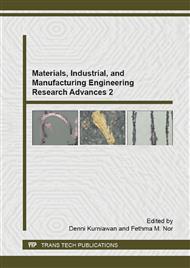[1]
A. Daoud, M.A. E, P. Rohatgi, Wear and friction behavior of near eutectic Al–Si+ ZrO2 or WC Particle Composites, Compos. Sci. Technol. 64 (2004) 1029-1040.
DOI: 10.1016/j.compscitech.2003.09.020
Google Scholar
[2]
A. Wang, I. Hutchings, Wear of alumina fibre–aluminum metal matrix composites by two-body abrasion, Mater. Sci. Tech. Ser. 5 (1989) 71-76.
DOI: 10.1179/mst.1989.5.1.71
Google Scholar
[3]
M. Surappa, S. Prasad, P. Rohatgi, Wear and abrasion of cast Al-alumina particle composites, Wear. 77 (1982) 295-302.
DOI: 10.1016/0043-1648(82)90055-2
Google Scholar
[4]
P. Bai, B. Ramasesh, M. Surappa, Dry sliding wear of A356-Al-SiCp composites, Wear. 157 (1992) 295-304.
DOI: 10.1016/0043-1648(92)90068-j
Google Scholar
[5]
J. Goni, I. Mitxelena, J. Coleto, Development of low cost metal matrix composites for commercial applications, Mater. Sci. Technol. 16 (2000), 743–746.
DOI: 10.1179/026708300101508739
Google Scholar
[6]
R. Arikan, S. Murphy, Anisotropic wear of planar-random metal matrix composites with zinc alloy matrix, Wear. 143 (1991) 149-157.
DOI: 10.1016/0043-1648(91)90091-8
Google Scholar
[7]
S. Farahany, A. Ourdjini, Effect of cooling rate and silicon refiner/modifier on solidification pathways of Al-11. 3 Si-2Cu-0. 4 Fe alloy, Mater. Manuf. Process. 28 (2013) 657-663.
DOI: 10.1080/10426914.2013.763972
Google Scholar
[8]
N. Hosseini, F. Karimzadeh, M. Abbasi, M. Enayati, Tribological properties of Al6061–Al2O3 nanocomposite prepared by milling and hot pressing, Mater. Design. 31 (2010) 4777-4785.
DOI: 10.1016/j.matdes.2010.05.001
Google Scholar
[9]
J. Archard, Contact and rubbing of flat surfaces, J. Appl. Phys, 24 (1953) 981-988.
DOI: 10.1063/1.1721448
Google Scholar
[10]
M. Sameezadeh, M. Emamy, H. Farhangi, Effects of particulate reinforcement and heat treatment on the hardness and wear properties of AA 2024-MoSi2 nanocomposites, Mater. Design. 32 (2011) 2157-2164.
DOI: 10.1016/j.matdes.2010.11.037
Google Scholar
[11]
A. Alpas, J. Zhang, Effect of SiC particulate reinforcement on the dry sliding wear of aluminium-silicon alloys (A356), Wear. 155 (1992) 83-104.
DOI: 10.1016/0043-1648(92)90111-k
Google Scholar
[12]
I. Polmear, Magnesium alloys and applications, Mater. Sci. Technol. 10 (1994) 1-16.
Google Scholar
[13]
M. Bermudez, G.M. N, F. Carrion, I.M. M, J. Rodrı́guez, E. Herrera, Dry and lubricated wear resistance of mechanically-alloyed aluminum-base sintered composites, Wear. 248 (2001) 178-186.
DOI: 10.1016/s0043-1648(00)00553-6
Google Scholar


